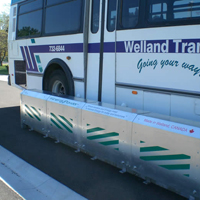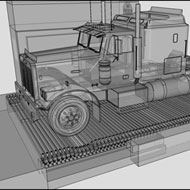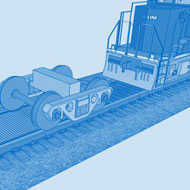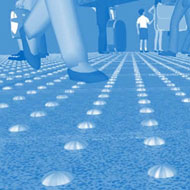
Background
KinergyPower, an American company, has developed a way to capture kinetic energy from weight and momentum of decelerating traffic and convert it into electricity. KinergyPower uses this motion and transforms the captured hydraulic pressure into the power to run a hydraulic generator unit, which produces electricity. The technology will be best employed where buses, trains, or other vehicles are breaking heavily, such as at bus or train terminals, intersections, curved sections of highways, school zones and parking lots. It is modular in design including "bumps" (like speed bumps), "carpets", "rails", and "pads" for pedestrians.
When a car is being operated, not all the energy generated from the fuel it uses goes to running the car. In fact, some energy is used and other energy is lost. Idling, braking, and accessories, such as radios, heaters, etc., all require some amount of the vehicle’s energy. KinergyPower harvests its energy from rolling resistance, and the deceleration and braking processes.
| When a vehicle is in operation, the energy that it uses is expended as follows: | |
| 62.4% | is used to propel the vehicle |
| 17.2% | is used in idling or standing by |
| 5.8% | goes to braking |
| 5.6% | driveline losses (ie., engine lubrication, etc) |
| 4.2% | rolling resistance |
| 2.6% | aerodynamic resistance due to the design of the vehicle |
| 2.2% | from accessory use within the vehicle |
(Source: Fuel Economy)
KinerBumps are an above-ground product designed to replace existing speed bumps. They can be used in areas where traffic normally has to slow down to a stop, such as bus stops, school zones, controlled access parking lots, drive-through windows, and intersections. KinerBumps harvest the energy from existing traffic so that it can be used to run nearby electrical signage or street lights. They are also available in a portable design so that this Smart Bump can be moved to different locations if necessary.
A KinerBump with a height of 3.5 inches and a travel length of 13 feet, with an additional 6.5 feet at the entrance and exit, produces 77 kWh of electricity per day when 10,000 cars go over it, assuming vehicle weights of 1,500kg. The average life of a KinerBump with regular maintenance is currently projected to be 10 years.
KinerBumps were temporally installed at the Walland Transit Center in June 2010. Niagara College and Brock University have helped collect data and monitor the results.
(Links to video clips of test prototypes in use: http://wn.com/Welland_City_Bus!)KinergyPower Carpets are a larger and longer length product designed for in-ground installations. Its greater length can accommodate more pistons of a greater diameter, harvesting more energy than the KinerBump unit. KinergyPower Carpets are ideally suited for use in bus depots, travel centers, toll plazas, port locations, and commercial distribution facilities.
| Facts | |
| KinergyPower Energy Carpet installed on 50 meters and traveled on by 250 cars a day or 10 trucks a day for one year will produce enough electricity to power one home for one year | A Bus Depot with traffic level of 1000 buses can harvest enough electricity to power 31 homes for one year |
| Energy Produced | |
| One KinergyPower Carpet placed to receive 10,000 vehicles per day will produce 51 kWh | The same KinergyPower Carpet placed in the path of 10,000 trucks per day will produce 1232 kWh |
KinerRail, still in the research and development phase, is designed to be placed within the train rails to harvest energy from the passing traffic of trains of all types.
KinerPad generates energy through pedestrian traffic. When the KinerPad is depressed by weight of the individual or individuals walking on it, the unit uses the energy gathered to illuminate the pad.
While the KinerPad unit does not generate the substantial amounts of energy, it can provide illumination in dark walkways and other areas where lighting and safety are a concern, and can be used in multiples in fun, kinetic, interactive art installations.
Adopted from: Kinergy Power
Lessons Learned
Potential Benefits:
- Produces electricity at a fraction of the cost of traditional energy sources.
- Emits no pollutants.
- Generates no hazardous waste.
- Uses no water and no fuel.
- Harvests energy regardless of the weather.
- Can be employed where buses, trains, vehicles are breaking heavily, such as bus or train terminals, intersections, curved sections of highways, school zones, and parking lots.
- ????
- ????
Potential Issues:
Sources
Fuel Economy. “Fuel Economy: Where the Energy Goes” (www.fueleconomy.gov/feg/atv.shtml)
Kinergy Power (http://www.kinergypower.com/applications_uses.shtml)
Photo Sources
MIG, Inc.



